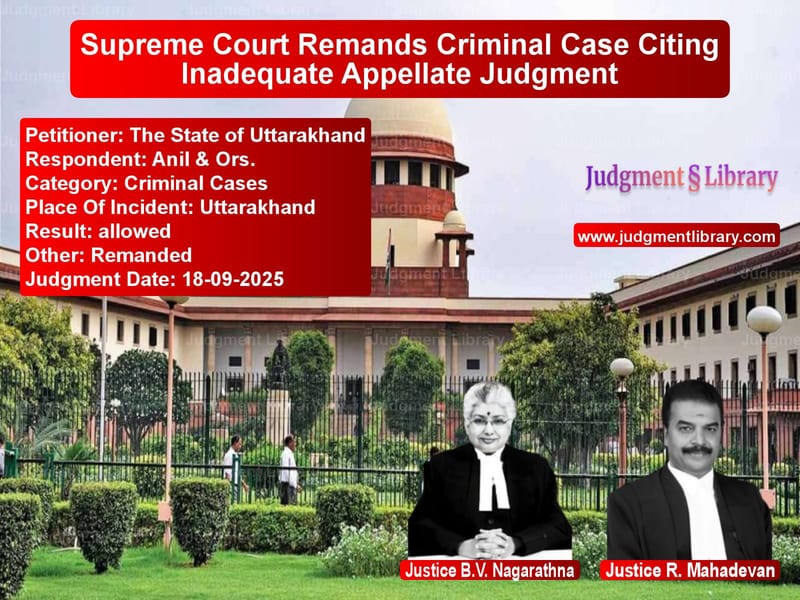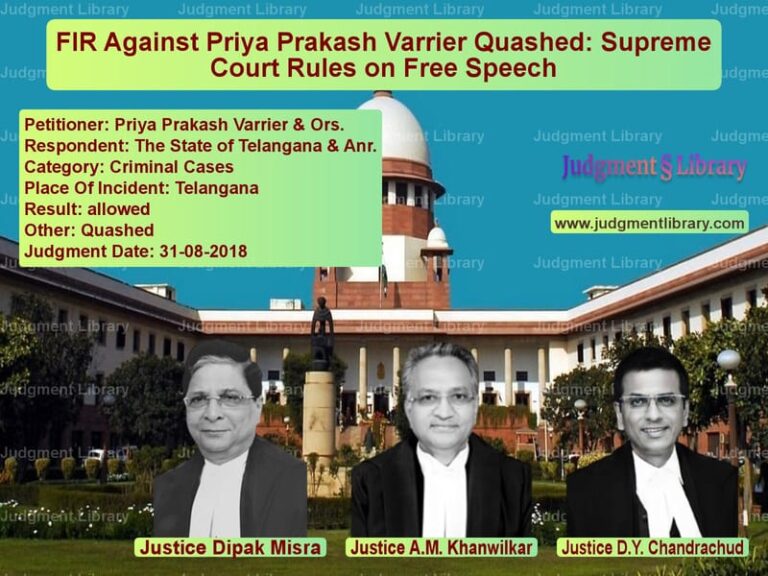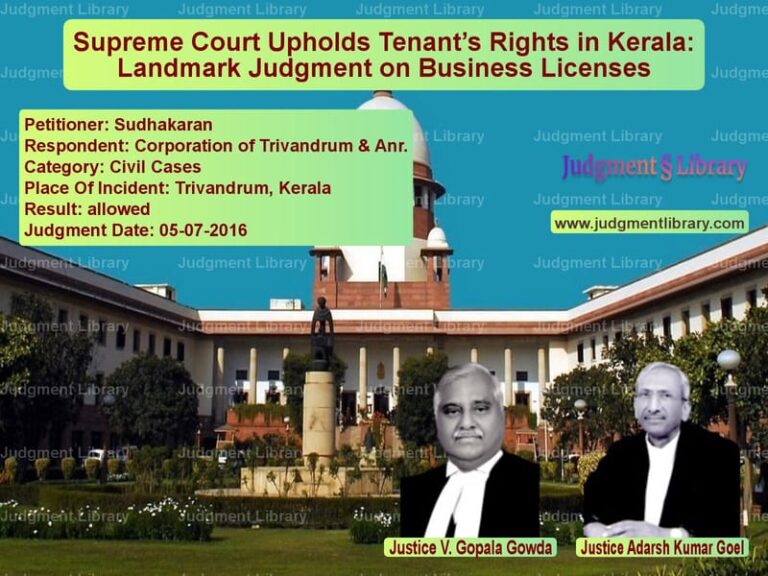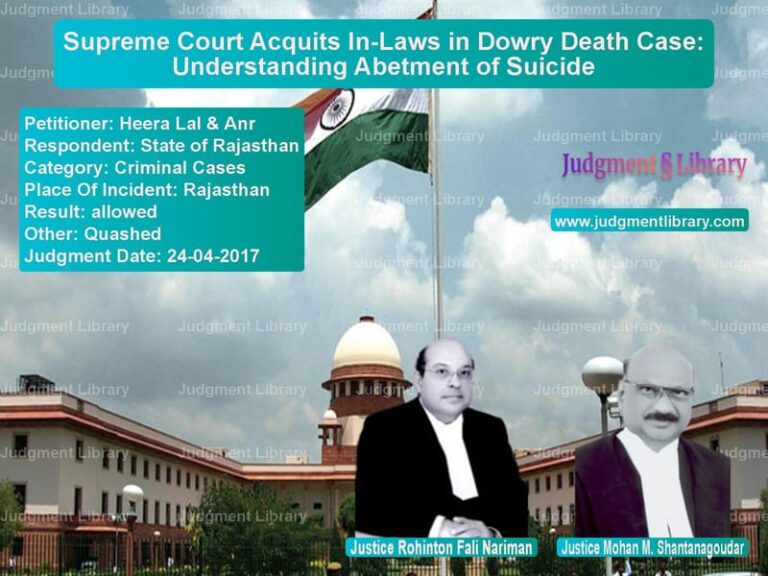Supreme Court Remands Criminal Case Citing Inadequate Appellate Judgment
In the hallowed halls of justice, where every word carries weight and every judgment shapes lives, the quality of judicial reasoning becomes as important as the verdict itself. This fundamental principle was recently underscored by the Supreme Court of India in a criminal case that traveled from the trial court to the highest judicial forum and back again. The case involving the State of Uttarakhand versus Anil and others represents more than just another criminal appeal—it serves as a crucial reminder of the solemn responsibilities that appellate courts bear when reviewing convictions that affect personal liberty. The story begins with a criminal trial that resulted in life imprisonment for some accused and shorter sentences for others, but takes an unexpected turn when the High Court’s acquittal decision comes under scrutiny not for its conclusion, but for its reasoning—or lack thereof.
The original case stemmed from Sessions Trial No. 50 of 2003, where the trial court had convicted the accused persons and sentenced Anil and Imran to life imprisonment, while Wasim and Pappu received one-year imprisonment plus fines. This judgment dated June 4, 2009, represented the culmination of a legal process that began with an incident dating back to 2002. The convicted individuals naturally exercised their right to appeal, filing Criminal Appeal Nos. 95, 97, and 98 of 2009 before the Uttarakhand High Court. In a decision that surprised the prosecution, the High Court delivered a common judgment on May 2, 2013, that completely reversed the trial court’s findings—acquitting all accused, ordering the release of those in jail, and discharging those on bail from their bonds. It was this acquittal judgment that the State of Uttarakhand challenged before the Supreme Court, leading to the current appeals.
The State’s Contentions Against the High Court Judgment
The appellant-State, represented through its counsel, mounted a two-pronged attack against the High Court’s judgment. The first and primary contention focused not on the merits of the case but on the manner in which the High Court had discharged its appellate function. The State’s counsel argued that “even without going into the merits of the case, the manner and tenor of the judgment may be considered; that this is a judgment of a High Court which was considering a first appeal against a judgment and order of conviction against which appeals were filed by respondents – accused; that in a cryptic manner, the judgment has been delivered by the High Court acquiring the respondents – accused.” This argument highlighted a fundamental concern about appellate justice—that reversal of conviction, especially in serious cases involving life imprisonment, cannot occur without thorough reasoning.
The State emphasized that the High Court had completely set aside the life imprisonment sentence and granted “complete acquittal given to the respondents – accused without there being any reasons and marshalling of the facts and the evidence on record.” Drawing attention to paragraphs 2 and 3 of the impugned judgment, the State’s counsel submitted that “the findings in paragraph 3 of the impugned judgment are de hors any basis in the absence of there being a discussion of the facts and evidence on record.” Based on these procedural shortcomings, the State requested that the matter be remanded back to the High Court for fresh consideration, without the Supreme Court needing to examine the case merits.
The State’s alternative submission was that if the Supreme Court was not inclined to accept the first argument, then the appeals should be considered on merits. On this front, the State contended that “even on merits, the High Court could not have given a judgment of acquittal by reversing the judgment of the Sessions Court.” The State ultimately sought setting aside of the High Court’s judgment and restoration of the Sessions Court’s conviction.
The Defence’s Counter-Arguments
Facing the State’s challenge, the counsel for the respondents-accused who had been acquitted mounted a vigorous defense of the High Court’s judgment. They vehemently contended that “there is no merit in the submissions made by the appellant’s counsel.” The defence lawyers drew the Court’s attention to the fact that “the High Court may have given the judgment pithily but it is not without substance.” This argument sought to defend the brevity of the High Court’s reasoning as a virtue rather than a vice.
The defence team made a crucial distinction between the length of a judgment and its legal soundness, arguing that “merely because the impugned judgment is short and not a lengthy one cannot make it an erroneous judgment as the reasoning is evident and there is a basis for the findings arrived at.” Confident in their position, the defence counsel declared that they were “ready to argue the matter on merits so that this Court could confirm the judgment of acquittal passed by the High Court.” This positioned them to defend the acquittal on both procedural and substantive grounds.
The Supreme Court’s Elaboration on Appellate Responsibilities
The Supreme Court bench comprising Justice B.V. Nagarathna and Justice R. Mahadevan delivered a judgment that extensively elaborated on the responsibilities of appellate courts in criminal matters. The Court observed that “while hearing appeals under Section 374(2) of the CrPC, the High Court is exercising its appellate jurisdiction. There has to be an independent application of mind in deciding the criminal appeal against conviction.” This statement underscored the active role that appellate courts must play in reviewing convictions.
The Court elaborated on the specific duties of an appellate court, stating that “It is the duty of an appellate court to independently evaluate the evidence presented and determine whether such evidence is credible. Even if the evidence is deemed reliable, the High Court must further assess whether the prosecution has established its case beyond reasonable doubt.” The judgment emphasized that “The High Court, though being an appellate Court, is akin to a Trial Court and must be convinced beyond all reasonable doubt that the prosecution’s case is substantially true and that the guilt of the accused has been conclusively proven while considering an appeal against conviction.”
The Supreme Court provided specific guidance on what this independent evaluation entails: “As the first appellate court, the High Court is expected to evaluate the evidence including the medical evidence, statement of the victim, statements of the witnesses and the defence version with due care.” While acknowledging that “the judgment need not be excessively lengthy,” the Court insisted that “it must reflect a proper application of mind to crucial evidence.” The Court recognized practical constraints, noting that “We are also cognizant of the large pendency of cases bombarding our courts. However, the same cannot come in the way of the Court’s solemn duty, particularly, when a person’s liberty is at stake.”
The judgment relied on precedents including State of Uttar Pradesh vs. Ambarish, where it was held that “while deciding a criminal appeal on merits, the High Court is required to apply its mind to the entirety of the case, including the evidence on the record before arriving at its conclusion.” Similar principles from Shakuntala Shukla vs. State of Uttar Pradesh and State Bank of India vs. Ajay Kumar Sood were also referenced to reinforce this position.
The Supreme Court’s Final Ruling and Directions
After examining the High Court’s judgment against these established legal standards, the Supreme Court found it wanting. The Court determined that “the High Court ought to have considered the evidence on record in light of the arguments advanced at the bar and thereafter ascertained whether the Sessions Court was justified in passing the judgment of conviction and imposing the sentence.” The Court noted that “The same being absent in the impugned judgment, for that sole reason, we set aside the same.” The Supreme Court particularly highlighted that “the High Court has not even referred to the case number and the trial court from which the appeals had arisen,” indicating the extent of the procedural lapse.
The Supreme Court ultimately accepted the State’s first contention, holding that “the impugned judgment of the High Court is cryptic and de hors any reasoning in coming to the findings in paragraph 3 of the said judgment.” Consequently, the Court set aside the High Court’s judgment “without expressing anything on the merits of the case.” The matters were remanded to the High Court of Uttarakhand at Nainital for fresh consideration.
The Supreme Court issued specific directions for the fresh hearing: “The High Court is requested to rehear the appeals filed by the respondents/accused respectively in these appeals by also giving an opportunity to the appellant-State herein to make its submission in the said appeals as well as the accused to make this submission in the matter.” The Court clarified that it had “not made any observations on the merits of the matter” and that “all contentions on both sides are left open to be advanced before the High Court.”
Recognizing the age of the case—with the original incident dating back to 2002—the Supreme Court requested that “the High Court dispose of the appeal as expeditiously as possible.” For the accused who had been granted bail, the Court ordered that they “shall remain on bail” but must appear before the concerned Principal District and Sessions Judge to execute fresh bonds. This balanced approach protected the accused’s liberty while ensuring proper judicial oversight during the fresh appellate process.
The Supreme Court’s judgment in this case serves as an important reaffirmation of the standards expected of appellate courts, particularly in criminal matters where personal liberty is at stake. By emphasizing that even acquittals must be based on proper reasoning and thorough examination of evidence, the Court has reinforced the integrity of the criminal justice system. The remand order ensures that justice is not just done, but seen to be done through a properly reasoned judicial process.
Petitioner Name: The State of Uttarakhand.Respondent Name: Anil & Ors..Judgment By: Justice B.V. Nagarathna, Justice R. Mahadevan.Place Of Incident: Uttarakhand.Judgment Date: 18-09-2025.Result: allowed.
Don’t miss out on the full details! Download the complete judgment in PDF format below and gain valuable insights instantly!
Download Judgment: the-state-of-uttarak-vs-anil-&-ors.-supreme-court-of-india-judgment-dated-18-09-2025.pdf
Directly Download Judgment: Directly download this Judgment
See all petitions in Bail and Anticipatory Bail
See all petitions in Criminal Defamation
See all petitions in Fraud and Forgery
See all petitions in Attempt to Murder Cases
See all petitions in Theft and Robbery Cases
See all petitions in Judgment by B.V. Nagarathna
See all petitions in Judgment by R. Mahadevan
See all petitions in allowed
See all petitions in Remanded
See all petitions in supreme court of India judgments September 2025
See all petitions in 2025 judgments
See all posts in Criminal Cases Category
See all allowed petitions in Criminal Cases Category
See all Dismissed petitions in Criminal Cases Category
See all partially allowed petitions in Criminal Cases Category







